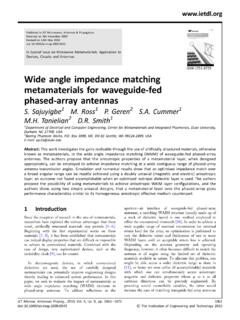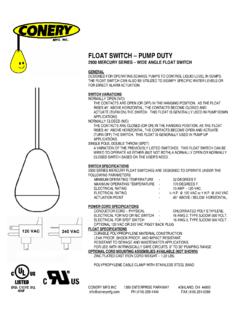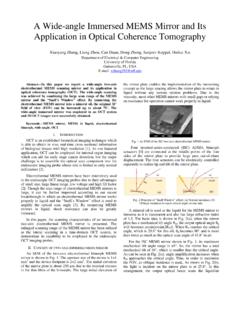Transcription of Wide-Angle LCDs and the Tablet PC - Pen Computing
1 This article attempts to make some sense outof those are a growing number of Tablet PCson the market with Wide-Angle screens (de-fined as having a viewing angle equal to orgreater than 100 in both directions). As ofmid-December 2004, the list includes the fol-lowing products: Fujitsu T4000 convertible HP TC1100 slate Motion M1400 slate LG-IBM T20 convertible Sharp TN10W convertibleHave you ever used a Tablet PC in por-trait mode and had trouble readingthe screen unless you held it at ex-actly the right angle? That s because mostTablet PCs today use standard notebookscreens that have been modified mechan-ically but not optically for use in a Tablet PC. Notebook screens usually have a widehorizontal viewing angle (typically 120 )and a narrow vertical viewing angle (typi-cally 45 ).
2 Although 45 doesn t sound likea very small angle, it s an absolute-maximumspecification that doesn t take into accountthe gray-scale inversion (photographic neg-ative effect), color shift and large decreasein contrast that occurs near the edge of theviewing cone. The usable portrait-modeviewing cone is actually only about 15 - 20 . The reasons notebook screens are de-signed with these viewing angles are (1)multiple people often view a notebookscreen in a horizontal group around thescreen, and (2) it s very easy to adjust ahinged notebook screen to the best verticalviewing angle, so a wide vertical viewing an-gle isn t necessary. Notebook screens aretherefore all optimized for horizontal ratherthan vertical Tablet PC, however, is used in bothlandscape (horizontal) and portrait (verti-cal) modes.
3 Ideally the screen should haveequal viewing angles in both why don t more Tablet PCs have Wide-Angle screens? The answer is a complexblend of technical and business discussion of Wide-Angle display technologiesby Geoff WalkerAt least six or seven more Tablet PCs withwide-angle screens will be added to thislist during you ve used a Tablet PC with awide-angle screen, you ll never want to goback to notebook screens. A wide -anglescreen makes an amazing difference in theease of use. You can show a portrait-modeimage to a group of people with absolute-ly no problem. You can look over some-one s shoulder and see the screen perfect-ly.
4 You can use the Tablet PC on your lap orread it in bed with much less fatigue. Awide-angle screen doubles the value of aTablet LCDs and the Tablet PCTable 1: Possible Tablet PC LCD sizes SizeResolutionPixelsDPIM icrosoft sCurrent Tablet PCView (1)LCD "SVGA800 x "XGA1024 x 768152 Optimal (+L) "WSVGA1024 x "XGA1024 x 768123 OptimalToshiba & Hydis (2) "WXGA1280 x 800144 Optimal (+L) "XGA1024 x 768106 Sub-optimalToshiba & Hydis (2) "WXGA1280 x "SXGA+ 1400 x 1050145 Optimal (+L) "XGA1024 x 76891 Sub-optimalAUO & "WXGA1280 x "SXGA+ 1400 x "UXGA 1600 x 1200145 Optimal (+L) "WSXGA+ 1680 x "WUXGA 1920 x 1200147 Optimal (+L)NoneNote (1): "Sub-optimal" means that Microsoft believes the LCD s pixel resolution or dpi are too low foracceptable Tablet PC performance.
5 "(+L)" means that Microsoft considers the LCD optimal for usewith Longhorn due to the new Windows operating system s resolution (2): Hydis is currently the only LCD vendor supplying Wide-Angle Tablet PC LCDsThe pictureto the leftshows thedrastic differ-ence in verticalscreen anglereadabilitybetween theHydis display in aFujitsu T4010(left) and theToshiba displayin a ToshibaPortege 3500(right). Theimage wastaken, withoutnflash or extralighting, withthe units sittingside by Computing Computing MAGAZINE 65 wide -ANGLETECHNOLOGIESIn late 1995, Hitachi invented in-planeswitching (IPS), the first technology usedto accomplish Wide-Angle viewing. IPS is amethod of aligning the liquid crystals inthe LCD horizontally so that there is less vari-ation in the optical characteristics due to view-ing angle.
6 In a standard LCD, the liquidcrystals are twisted and tilted such that thelight that travels through them is restrictedto a relatively narrow angle. In 1996, Fujitsu invented vertical align-ment (VA) and then enhanced it into mul-ti-domain vertical alignment (MVA) in1997. MVA is the other main technologyused to accomplish Wide-Angle viewing. InMVA, liquid crystals are aligned vertically inseveral horizontal planes ( domains ). Theend result is essentially the same as IPS in-creased viewing angle, high contrast and nocolor shift. Both Hitachi and Fujitsu licensed theirtechnology to other LCD vendors, many ofwhom made their own improvements. Twoexamples are and Samsung, thetwo largest LCD vendors in the world.
7 Theformer uses a version of IPS, while the lat-ter uses a version of MVA. Both claim theirwide-angle technology is the best; in real-ity, they re converging on the same point. When Wide-Angle LCD PC monitorswere first introduced, a viewing angle of130 was considered state-of-the-art. Today,the latest monitors are all between 170 and 180 , which doesn t leave much roomfor improvement!Until recently, PC monitors were the tar-get on which the LCD vendors focused theirwide-angle technology. However, in thelast two years, the LCD-TV has become thenewest hot target for the LCD viewing is certainly very im-portant in an LCD-TV, but other factorshave been added to the mix, such as fast re-sponse time (required for no-smear full-motion video).
8 This has created anothercompetitive battleground for the LCD ven-dors, causing most of them to move be-yond competing on viewing angle, sincethere isn t much perceptible difference be-tween 170 and 180 .ONEMOREWIDE-ANGLETECHNOLOGYT here s one more Wide-Angle technologythat s worth mentioning (particularly withregard to Tablet PCs), and that s film com-pensation . In this technology, special filmsare added above and below the LCD. Thefilms chemical structure mimics the twist-ed and tilted alignment of liquid crystals, butin the opposite direction, thus compen-sating for the narrow viewing angle of nor-mal liquid crystals. Compensation filmscan extend the viewing angle up to 100 - 120 in both , there s a fundamental dif-ference between film compensation andthe IPS/MVA liquid-crystal-alignment meth-ods.
9 Film compensation can be applied toan existing LCD with only a small materialcost increment (about 1%) and little effecton yield. If a particular market demandswide viewing angles ( , the Tablet PCmarket), an LCD vendor can develop newmodels of existing LCDs with little investmentand still remain the other hand, the IPS/MVA liquid-crystal-alignment methods significantly in-crease the cost of an LCD. The reason isn tmaterial cost, but instead, process IPS or MVA to a standard LCD de-creases the yield by as much as 30%, whichincreases the cost of an LCD to the pointwhere it becomes non-competitive. In ad-dition, both IPS and MVA increase the pow-er consumption of an LCD, which alsomakes the LCD less competitive in battery-powered applications.
10 The result is that it simpractical to apply IPS/MVA liquid-crys-tal-alignment methods to notebook-sizeLCDs when none of the competitors areusing them. In the monitor/TV market, it sa more level playing field, since the major-ity of the LCD vendors are using IPS orMVA. WHAT ABOUTMOBILEPC LCDS?Where are mobile PCs (notebooks or TabletPCs) in all this discussion about wide -angletechnologies? Nowhere. There has neverbeen any demand for symmetrical wideviewing angles in notebooks, so none ofthe LCD vendors have had any motivationto spend time or resources developing Wide-Angle , notebook-sized LCDs. Tablet PCsare so new that there s not enough demandto drive any of the LCD vendors to do any-thing special for them with two significantexceptions, Toshiba and BOE Hydis.









